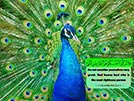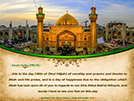The Sources of Creation
- Details
- Hits: 2067
The Sources of Creation
With a view to make a study in respect of the source of the creation and the first cause of the development of the universe, it is necessary to give careful consideration to the following points:
1. The world is a reality
The world is a reality which can be felt, observed and perceived. It is not something imaginary or the produce of the conception or notion of anybody. Irrespective of what we think about it and irrespective of the fact whether its phenomena are known to man or not and whether they are put to any use or not, it is an absolute and indisputable reality.
From the point of view of experimental knowledge also the existence of the universe is indisputable, for its phenomena are subject to scientific investigation and research. Had its reality been doubtful, all the scientific effort and research would have been useless and in vain.
2. The world is well‑organized
Through observation, experiment and calculation man has found that the world is well‑organized. There exist definite relations between its elements and its phenomena, and it is governed by firm laws. Normally the object of all scientific research is the discovery of these very laws and relations.
The existence of this systematic organization is so definite that no natural event is considered to be haphazard and having no relation with other phenomena. If it is found that the cause of a phenomenon is not known, various kinds of investigations are carried out for years till its cause is discovered. On the other hand if a law is discovered, its generality and firmness are regarded to be so sure that on its basis big industrial plants are set up and thousands of appliances and implements are manufactured.
Thus the world with all its dimensions has systematic interrelations at all levels, which are so precise and complex that they are evidently well‑calculated.
The progress of science has disclosed that there are definite laws governing the natural phenomena.
"The sun and the moon move according to a reckoning. The plants and the trees submit to His command. He has raised the heaven and has set a standard (law) for that". (Surah al‑Rahman, 55:5 ‑ 7).
3. `To become' and its cause
We find a continuous change and development in all the natural phenomena. This change is more evident and conspicuous among the living beings. A tree grows. It bears flowers which open gradually and then wither. The flowers mature slowly into fruits and grains.
The cells of human seed grow slowly and are transformed into an embryo. It develops continuously and ceaselessly till it is delivered. Then the new‑born continues to grow to become old and finally aged.
`To become' may be expressed as flowing and gradual existence. At every stage a being is different from what it was from what it will be. But in any case a bond exists between these beings and on the whole it is one `flowing being'.
But it is to be seen what causes this `to become'. What is the source of this making, mixing and finding? Why does this development, based on precise and systematic calculation, occur?
4. Cause of systematic development and changes
The harmony and methodical composition found in millions of natural phenomena require a suitable factor. For its growth a plant requires the necessary quantity of the mixture of soil, rain water, solar energy and air components, so that it may bloom and blossom. Which is the power that arranges this working together, mutual attraction and mutual influencing? Why do the various elements in a precise quantity and under specific conditions come together to produce the required effect?
5. Not an accident
If you take a handful of printing types, put them in a bowl, mix them well and then throw them out on a clean surface, how much is the possibility that the letters will be set so precisely that they will cast a whole poem of a famous poet? Naturally the possibility is almost nil.
Or alternately put a type writer before a two‑year old child and let him press the keys with his little fingers. After he has played with the keys for half an hour, see if he has typed an extract from a philosophical treatise of Avicena in Arabic. How far is this possible? Is this conception rational?
It is said that the possibility of the accidental combination of the raw material and the conditions precedent to the coming into being of a living cell are equal to a figure divided by 1016.
A scientist has said that the possibility of the accidental existence of the chain material necessary for the coming into being of a simple protoplasm particle is equal to a figure divided by 104 8 .
Therefore it is evident that all these changes and the development of `becoming', are governed by precise and well‑calculated scientific laws and are the result of the combination of varied elements and specific conditions. Science has rendered a great service by discovering that there is nothing accidental and haphazard.
6. Is contradiction the cause of `becoming'?
According to the theory of dialectical materialism, every material thing has within it a seed of its death or a seed of inner contradiction, which gradually leads to its destruction. Anyhow, from the heart of death a new life is born.
In other words, as soon as an idea, an incident or any thesis comes into existence, it excites an opposition to itself from within itself. This opposition is called antithesis. Later as the result of a struggle between the, two, a synthesis of them, having a more developed form, comes into being.
Thus the basic cause of the development of everything lies within itself and not outside it. This cause is the contradictory nature of everything and every phenomenon, which produces every movement and all contradictions. In the vegetable and animal kingdoms all natural developments are produced basically by inner contradiction. The same applies to all other developments of the world.
Thus everything comes out of matter and the factor causing its development lies within itself. Every thing is accompanied by contradiction and conflict, which always tend towards evolution.
Now let us see if matter can really have all this power? To what extent is this theory scientific and how far is it supported by the experiments so far carried out?
Is this principle actually universal? Does every change and every development really tend towards evolution or are there instances in which this principle is not applicable? Is contradiction always the main factor behind a movement, or do the forces of attraction and cohesion also work in many cases?
In the course of our forthcoming explanation we will give answer to these questions.
Modern science while discussing the various organic and inorganic systems composed of groups comprising allied material elements, put them in ten ascending classes or levels and divides them into open and closed systems. It declares that:
Only the open systems, and those too under some specific circumstances, can maintain their quality of self‑preservation, propagation and evolution. An open system is that group of things which has a link of conversion with other things. For example it assimilates food and energy and evaluates what is superfluous or harmful.
But the closed systems having little capacity of conversion and propagation, can make nothing besides themselves. It is important to note that closed systems normally produce no automatic change, and even if they have any life and movement, the change which takes place in them, is accompanied by their decay and loss of their effective energy and efficiency.
Incidentally, only the systems comprising living and purposive elements can have an evolutionary change tending towards an increase in their formative arrangement and efficiency, leading to their expansion.
No simple or compound matter and no closed system can ever make itself without outside help. Similarly no collection of various kinds of matter and no group of systems has the power of creating and managing any orderly, well-arranged motile and evolutionary arrangement or system. For this purpose every kind of matter individually and even collectively requires some outside contact and help.
As it is now evident that such an arrangement cannot emerge automatically from within matter, we must look for outside factor to explain its existence, and as we know that the existing arrangement is well‑calculated and orderly, that factor must have consciousness and will to create it.











